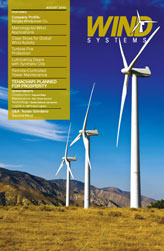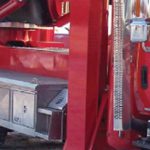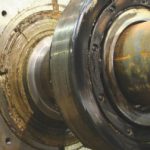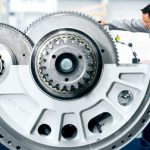Increasing global reliance on wind energy means that more wind turbines are being built each year, and these massive structures require regular maintenance and repair. International Climbing Machines (ICM) has developed a remote-controlled device that provides a safe alternative to traditional methods for the inspection, repair, and maintenance of wind turbine towers and blades. ICM climbers are small (approximately 24” length x 24” width), lightweight (40 lbs.), remote-controlled devices that can adhere to steel, composite, ferrous, or nonferrous surfaces. They can access both wind turbine towers and blades and they are extremely flexible, maneuvering over obstacles like bolts and weld seams with ease. Moreover, ICM climbers have high payload capacity to deploy cameras, ultrasonic testing sensors, cleaning heads, coating removal tools, epoxy injection equipment, paint spraying guns, and other devices the job requires.
Current Challenges
Blade maintenance and repairs are rapidly becoming a considerable portion of a wind turbine’s maintenance costs. To keep them turning and producing at their optimum output, wind turbine blades need to be inspected and maintained regularly. Damaged, dirty, or faulty blades can reduce the overall productivity of a turbine and should be repaired and cleaned as part of the operator/owners preventative maintenance program. By carrying out a thorough inspection of the wind turbine blades each year, the owner/operator is reducing the risk of a catastrophic failure by highlighting issues early and taking action immediately. The damage is often found long before it spreads, allowing for a much smaller repair and ultimately less downtime. Figure 1
Wind turbine blades can be damaged or degraded by several factors. Working at optimum wind conditions, a blade tip could be turning at speeds well over 100 miles an hour. Over time sand, ice, rain, UV rays, and insects—just to name a very few—can have serious adverse effects on the leading edge. Lightning and bird strikes can also lead to serious damage and reduction in productivity. Over time the blade is subjected to a serious amount of damage, often starting with a small problem that if caught early enough could save a huge amount of money, downtime, and lost revenue. Blade inspections and regular maintenance are not a luxury, they are a necessity.
Current Approaches
Wind turbine towers and blades present unique challenges to “access” the surfaces. They are very high off the ground, after all. Until now wind turbine towers and blades have been serviced either by removing the blades and transporting them to a facility for repair, in the field using cranes or, in some cases, rappelling to allow workers access. In-house blade repair is costly and requires downtime. Repairs and services using cranes to lift technicians and loads is a common requirement for turbine operations and maintenance work. This work is performed in windy conditions, and at extreme heights. Conventionally, accessing the surfaces of the towers and the blades has been achieved by rappelling workers from the nacelle, or using cranes or “cherry pickers” to lift the workers and their equipment to the surface. This is expensive, dangerous, and time consuming.
Design Advantages
Due to the inherent danger of current methods for wind turbine maintenance, ICM climbers present a clear advantage by keeping the people making repairs on the ground instead of climbing the heights themselves, using what is essentially a gaming controller to guide a machine to do the work. Using cameras as virtual eyes in the sky, the operator can see what the climber is doing and remotely use it to make repairs, inspect for faults or cracks, and perform any other tasks they would otherwise be doing themselves. Because the ICM climber is a free-climbing device, it does not require any scaffolding or cranes, both of which are costly and time consuming. Figure 2
The ICM climber is not the only robotic device used to climb surfaces, but it presents many advantages over other devices. The ICM climber is held to the surface with a patented technology. Essentially, the ICM technology is an onboard vacuum chamber surrounded by a rolling, flexible, and locomoting seal. This exceptional approach achieves what no other method can: It establishes adhesion to virtually any surface, ensures the climber can negotiate weld seams, surface irregularities, etc., and it locomotes the machine with the seal itself, whereby all the force provided by the vacuum is transferred to the locomoting assembly. In short, this provides surefooted traction unlike any wheeled or tracked crawler where the method of adhering the device to the surface and the method to drive it are separate or individualized. With the ICM technology the vacuum seal around the chamber and the locomoting element are one in the same, and its advantages are significant and very real.
This unique adhesion seal allows the climber to scale ferrous or nonferrous metals, concrete, brick, and composites, etc. Magnetic crawlers are obviously limited to ferrous metals, but the ICM climber is unaffected by the degree of rust that may be on the steel walls. Magnetic crawlers are highly affected by the rust layer, to the degree where they can fall off the vertical wall if the rust is too thick. Moreover, magnetic-type crawlers often have a buildup problem where metal and ferrous particle debris accumulates on the magnetic wheels or tracks, rendering the vehicle ineffectual at adhering to the vertical surface. ICM climbers cannot and will not be adversely affected by rust or debris.
ICM technology also has the ability to transition from floor to wall, and from wall back down to the floor if needed, and it is conducive to attaching an array of tools and/or capabilities to the same climber. For example, it is feasible for the same ICM climber to have onboard camera, cleaning tool, EMAT sensor, and other UT sensors. Also, it is possible for tools to be attached, detached, and reattached with minimal time and/or exposure to workers. Figure 3
In addition, the manner in which the ICM climbers traverse the surface—rolling along at a speed that can be accurately and evenly controlled from 0 to 3 inches per second—makes them conducive for regular and uniform surface cleaning, scanning, and measuring. The other approaches, using an inchworm or “fasten-move-refasten” approach for traversing along a surface, are not at all favorable for surface cleaning, scanning, or measuring.
Plus, the ICM climbers are very lightweight since they are primarily constructed of carbon fiber and epoxy. The rolling seal elements are made of highly durable yet lightweight composites of closed cell foam wrapped around open cell foam. The base ICM climber weighs approx 25 pounds. The tools and capabilities then mounted onboard the climber always employ the most strict weight-shaving regimen to keep the overall weight as low as possible. Figure 4
ICM climbers are ideal for any type of work being conducted on wind turbine towers and blades. With the imminent growth of the wind energy market, and the growing demand for more-efficient and safe approaches, ICM climbers are proving to be the future for the field of wind turbine inspection, repair, and maintenance.








































